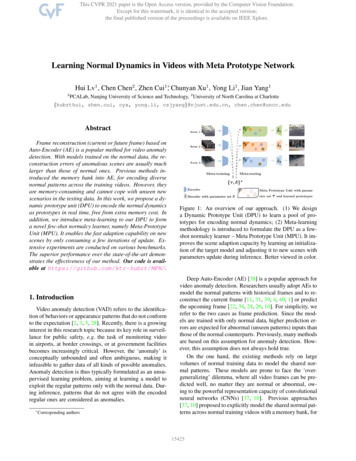
Transcription
Learning Normal Dynamics in Videos with Meta Prototype NetworkHui Lv1 , Chen Chen2 , Zhen Cui1 *, Chunyan Xu1 , Yong Li1 , Jian Yang12PCALab, Nanjing University of Science and Technology, 2 University of North Carolina at Charlotte{hubrthui, zhen.cui, cyx, yong.li, csjyang}@njust.edu.cn, chen.chen@uncc.eduAbstractFrame reconstruction (current or future frame) based onAuto-Encoder (AE) is a popular method for video anomalydetection. With models trained on the normal data, the reconstruction errors of anomalous scenes are usually muchlarger than those of normal ones. Previous methods introduced the memory bank into AE, for encoding diversenormal patterns across the training videos. However, theyare memory-consuming and cannot cope with unseen newscenarios in the testing data. In this work, we propose a dynamic prototype unit (DPU) to encode the normal dynamicsas prototypes in real time, free from extra memory cost. Inaddition, we introduce meta-learning to our DPU to forma novel few-shot normalcy learner, namely Meta-PrototypeUnit (MPU). It enables the fast adaption capability on newscenes by only consuming a few iterations of update. Extensive experiments are conducted on various benchmarks.The superior performance over the state-of-the-art demonstrates the effectiveness of our method. Our code is available at https://github.com/ktr-hubrt/MPN/.1. IntroductionVideo anomaly detection (VAD) refers to the identification of behaviors or appearance patterns that do not conformto the expectation [2, 3, 5, 28]. Recently, there is a growinginterest in this research topic because its key role in surveillance for public safety, e.g. the task of monitoring videoin airports, at border crossings, or at government facilitiesbecomes increasingly critical. However, the ‘anomaly’ isconceptually unbounded and often ambiguous, making itinfeasible to gather data of all kinds of possible anomalies.Anomaly detection is thus typically formulated as an unsupervised learning problem, aiming at learning a model toexploit the regular patterns only with the normal data. During inference, patterns that do not agree with the encodedregular ones are considered as anomalies.* CorrespondingauthorsFigure 1: An overview of our approach. (1) We designa Dynamic Prototype Unit (DPU) to learn a pool of prototypes for encoding normal dynamics; (2) Meta-learningmethodology is introduced to formulate the DPU as a fewshot normalcy learner – Meta Prototype Unit (MPU). It improves the scene adaption capacity by learning an initialization of the target model and adjusting it to new scenes withparameters update during inference. Better viewed in color.Deep Auto-Encoder (AE) [38] is a popular approach forvideo anomaly detection. Researchers usually adopt AEs tomodel the normal patterns with historical frames and to reconstruct the current frame [11, 31, 39, 4, 40, 1] or predictthe upcoming frame [22, 34, 24, 26, 10]. For simplicity, werefer to the two cases as frame prediction. Since the models are trained with only normal data, higher prediction errors are expected for abnormal (unseen patterns) inputs thanthose of the normal counterparts. Previously, many methodsare based on this assumption for anomaly detection. However, this assumption does not always hold true.On the one hand, the existing methods rely on largevolumes of normal training data to model the shared normal patterns. These models are prone to face the ‘overgeneralizing’ dilemma, where all video frames can be predicted well, no matter they are normal or abnormal, owing to the powerful representation capacity of convolutionalneural networks (CNNs) [37, 10]. Previous approaches[37, 10] proposed to explicitly model the shared normal patterns across normal training videos with a memory bank, for15425
the propose of boosting the prediction of normal regions inframes while suppressing the abnormal ones. However, it isextremely memory-consuming for storing the normal patterns as memory items across the whole training set.To tackle this limitation, we propose to encode the normal dynamics in an attention manner, which is proven tobe effective in representation learning and enhancement[46, 20, 13]. A normalcy learner, named as Dynamic Prototype Unit (DPU), is developed to be easily incorporatedinto the AE backbone. It takes the encoding of consecutivenormal frames as input, then learns to mine diverse normaldynamics as compact prototypes. More specifically, we apply a novel attention operation on the AE encoding map,which assigns a normalcy weight to each pixel location toform a normalcy map. Then, prototypes are obtained as anensemble of the local encoding vectors under the guidanceof normalcy weights. Multiple parallel attention operationsare applied to generate a pool of prototypes. With the proposed compactness and diverseness feature reconstructionloss function, the prototype items are trained to represent diverse and compact dynamics of the shared normal patternsin an end-to-end fashion. Finally, the AE encoding mapis aggregated with the normalcy encoding reconstructed byprototypes for latter frame prediction.On the other hand, the normal patterns appearing in various scenes differ from each other. For instance, a personrunning in a walking zone is regarded as an anomaly, whilethis activity is normal in the playground. Previous methods [22, 10] assume the normal patterns in training videosare consistent with those of test scenes in the unsupervisedsetting of VAD. However, this assumption is unreliable, especially in real-world applications where surveillance cameras are installed in various places with significantly different scenarios. Therefore, there is a pressing need to developan anomaly detector with adaption capability. To this end,[37] defines a rule for updating items in the memory bankbased on a threshold to record normal patterns and ignoreabnormal ones. However, it is impossible to find a uniformand optimal threshold for distinguishing the normal and abnormal frames under various scenarios.In this work, we approach this problem from a new perspective, motivated by [25], which is the few-shot settingfor video anomaly detection. In the few-shot setting, videosfrom multiple scenes are accessible during training, and afew video frames from target scene are available duringinference. A solution to this problem is using the metalearning technique. In this meta-training phase, a few-shottarget model is trained to adapt to a new scene with a fewframes and parameters update iterations. The procedure isrepeated using video data from different scenes for obtaining a model initialization that serves as a good starting pointfor fast adaption to new scenes. Therefore, we formulateour DPU module as a few-shot normalcy learner, namelyMeta Prototype Unit (MPU), for the goal of learning to learnthe normalcy in target scenes. Rather than roughly shifting to the new scene by adjusting the whole network [25],which may lead to the ‘over-generalizing’ problem, we propose to freeze the pre-trained AE and only update the parameters of our MPU. Consuming only a few parametersand update iterations, our meta-learning model is enduedwith the power of fast and effective adaption to the normalcy of unseen scenarios. An overview of our approachis presented in Fig. 1.We summarize our contributions as follows: i) We develop a Dynamic Prototype Unit (DPU) for learning to represent diverse and dynamic patterns of the normal data asprototypes. An attention operation is thus designed for aggregating the normal dynamics to form prototype items.The whole process is differentiable and trained end-to-end.ii) We introduce meta-learning into our DPU and improveit as a few-shot normalcy learner – Meta Prototype Unit(MPU). It effectively endows the model with the fast adaption capability by consuming only a few parameters andupdate iterations. iii) Our DPU-based AE achieves newstate-of-the-art (SOTA) performance on various unsupervised anomaly detection benchmarks. In addition, experimental results validate the adaption capability of our MPUin the few-shot setting.2. Related WorkAnomaly Detection. Due to the absence of anomaly dataand expensive costs of annotations, video anomaly detection has been formulated into several types of learning problems. For example, the unsupervised setting assumes only normal training data [19, 27, 23], and weaklysupervised setting can access videos with video-level labels [43, 53, 28]. In this work, we focus on the unsupervised setting, which is more practical in real applications. For example, the normal video data of surveillancecameras are easily accessible for learning models describing the normality. Earlier methods, based on sparse coding [7, 51, 23], markov random field [14], a mixture of dynamic textures [30], a mixture of probabilistic PCA models [15], etc., tackle the task as a novelty detection problem [28]. Latter, deep learning (CNNs in particular) hastriumphed over many computer vision tasks including videoanomaly detection (VAD). In [27], Luo et al. propose a temporally coherent sparse coding-based method which can bemapped to a stacked RNN framework.Recently, many methods leverage deep Auto-Encoder(AE) to model regular patterns and reconstruct videoframes [11, 31, 39, 4, 40, 1]. Multiple variants of AE havebeen developed to cooperate spatial and temporal information for video anomaly detection. In [26, 6], the authors investigate Recurrent Neural Network (RNN) and Long ShortTerm Memory (LSTM) for modeling regular patterns in se-15426
Dynamic Prototype UnitDPUPool quential data. Liu et al. [22] propose to predict the future frame with AE and Generative Adversarial Network(GAN). They assume anomalous frames are unpredictablein the video sequence. It has achieved superior performanceover previous reconstruction-based methods. However, thiskind of methodology suffers from the ‘over-generalizing’problem that sometimes anomalous frames can also be predicted well (i.e. small prediction error) as normal ones.Gong et al. (MemAE) [10] and Park et al. (LMN) [37]introduce a memory bank into the AE for anomaly detection. They record normal patterns across training videos asmemory items in a bank, which brings extra memory cost.While we propose to learn the normalcy with an attentionmechanism to measure the normal extent. The learning procedure is fully differentiable and the prototypes are dynamically learned with the benefits of adapting to the currentscene spatially and temporally, compared with queryingand updating the memory bank with pre-defined rules forrecording rough patterns cross the training data in [10, 37].Moreover, the prototypes are automatically derived basedon the real-time video data during inference, without referencing to the memory items collected from the trainingphase [10, 37]. For adaption to test scenes, Park et al. [37]further expand the update rules of the memory bank by using a threshold to distinguish abnormal frames and recordnormal patterns. However, it is impossible to find a uniformand optimal threshold for distinguishing the normal and abnormal frames under various scenarios. On the contrary, weintroduce the meta-learning technology into our DPU module to enable the fast adaption capacity to a new scenery.Attention Mechanisms. Attention mechanism [48, 49, 13,42, 16, 50, 9, 52, 20] is widely adopted in many computer vision tasks. Current methods can be roughly divided into two categories, which are the channel-wise attention [49, 13, 42, 50] and spatial-wise attention [42, 52,49, 16, 9]. SENet [13] designs an effective and lightweightgating mechanism to self-recalibrate the feature map viachannel-wise importance. Wang et al. [48] propose a trunkand-mask attention between intermediate stages of a CNN.However, most prior attention modules focus on optimizing the backbone for feature learning and enhancement. Wepropose to leverage the attention mechanism to measure thenormalcy of spatial local encoding vectors, and use them togenerate prototype items which encode the normal patterns.Few-Shot and Meta-learning. In few-shot learning, researchers aim to mimic the fast and nimble learning abilityof humans, which can quickly adapt to a new scenario withonly a few data examples [18]. Generally, meta-learninghas been developed to tackle this problem. The metalearning methods mainly fall into three categories: metricbased [17, 47, 44], model-based [41, 33] and optimizationbased approaches [8]. These methods can quickly adapt toa new task through the meta-update scheme among mul-ED AE EncodingEEncoderDDecoderQueryEncodingEnsemble OperationAggregationEncodingAggregation OperationFigure 2: The framework of DPU-based model. The proposed Dynamic Prototype Unit (DPU) is plugged into anAuto-Encoder (AE) to learn prototypes for encoding normal dynamics. The prototypes are obtained from the AEencoding with the guidance of normalcy weights and thenormalcy weights of the AE encoding are generated in afully differentiable attention manner. Then an normalcy encoding map (green color) is reconstructed as an encodingof learned prototypes. It is further aggregated with the AEencoding map for latter frame prediction.tiple tasks during parameter optimization. However, mostof the approaches above are designed for simple tasks likeimage classification. Recently, Lu et al. [25] follow theoptimization-based meta-learning approach [8] and apply itto train a model for scene-adaptive anomaly detection. Theysimply set the whole network as the few-shot target modelfor meta-learning, for learning an initialization parameterset of the entire model. However, in this work, we learn twosets of initial parameters and update step sizes separatelyfor an elaborate updating of designed module in our modelwith fewer parameters and update iterations.3. MethodIn this section, we elaborate the proposed method forVAD. First, we describe the learning process of normal dynamics in the Dynamic Prototype Unit (DPU) in Sec. 3.1,and we explain the objective functions of the framework inSec. 3.2. Then in Sec. 3.3, we present the details of thefew-shot normalcy learner. Finally in Sec. 3.4, we detail thetraining and testing procedures of our VAD framework.3.1. Dynamic Prototype UnitThe framework of the DPU-based AE is shown in Fig. 2.DPU is trained to learn and compress normal dynamics ofreal-time sequential information as multiple prototypes andenrich the input AE encoding with normal dynamics information. Note that, DPU can be plugged into different places(with different resolutions) of the AE. We conduct ablationstudies in Sec. 4.4 to analyze the impact of DPU position.Let’s first consider an AE model takes as inputs the Tobserved video frames (Ik T 1 , Ik T 2 , ., Ik ), simplified15427
as xk . Then the selected hidden encoding of AE is feed forward into our DPU Pτ : Rh w c Rh w c . Finally, theoutput encoding of DPU is run through the remaining AElayers (after DPU) for predicting upcoming ground-truthframe yk Ik 1 . We denote the frame sequence as aninput&output pair (xk , yk ) of the k-th moment.The forward pass of DPU is realized by generating apool of dynamic prototypes in a fully differentiable attention manner, then reconstructing a normalcy encoding byretrieving the prototypes, and eventually aggregating the input encoding with the normalcy encoding as the output. Thewhole process can be broken down into 3 sub-processes,which are Attention, Ensemble and Retrieving.Concretely, the t-th input encoding map Xt fθ (xt ) Rh,w,c from AE is first extracted, viewed as N w h vectors of c dimensional, {x1t , x2t , ., xNt }. In the sub-processof Attention, a quantity of M attention mapping functions{ψm : Rc R1 }Mm 1 are employed to assign normalcyweights to encoding vectors, wtn,m Wtm ψm (Xt ). Oneach pixel location, the normalcy weight measures the normalcy extent of the encoding vector. Here, Wtm Rh w 1denotes the m-th normalcy map, generated from the m-thattention function. Then one unique prototype pmt is derived as an ensemble of N encoding vectors with normalizednormalcy weights in sub-process Ensemble as:pmt NXn 1PNwtn,mn′ 1wtn ,m′xnt .MXβtn,m pmt ,L Lfra λ1 Lfea .Lfra kŷt yt k2 .where xn p mP M t t n m′x pm′ 1 t t(4)Feature Reconstruction Loss is designed to make thelearned normal prototypes have the properties of compactness and diversity. It has two terms Lc and Ld , aiming atthe two properties respectively, and is written as:Lfea Lc λ2 Ld ,(5)where λ2 is the weight parameter. The compactness termLc is for reconstruction of normalcy encoding with compact prototypes. It measures the mean L2 distance of inputencoding vectors and their most-relevant prototypes as:Lc N1 X nkx p t k2 ,N n 1 ts.t., argmax βtn,m ,(6)(7)m [1,M ](2)where β n,m is the relevant score mentioned in Eq. 2. Notethat, argmax is only used to obtain indices of the mostrelevant vector, and not involved in the back-propagation.We further promote the diversity among prototype items bypushing the learned prototypes away from each other. Thediversity term Ld is expressed as:Ld m 1βtn,m(3)Frame Prediction Loss is formulated as the L2 distancebetween ground-truth yt and network prediction ŷt :(1)Similarly, M prototypes are derived from multiple attentionMfunctions to form a prototype pool, Pt {pmt }m 1 .Finally, in the Retrieving sub-process, input encodingvectors xnt (n N) from the AE encoding map are usedas queries to retrieve relevant items in the prototype poole t Rh w c . Forfor reconstructing a normalcy encoding Xevery obtained normalcy encoding vector, this proceeds as:x̃nt normalcy enhanced encoding, and frame prediction foranomaly detection. To train our model, the overall lossfunction L consists of a feature reconstruction term Lfeaand a frame prediction term Lfra . These two terms are balanced by weight λ1 as:denotes the relevant score be-tween the n-th encoding vector xnt and the m-th prototypeitem pmt . The obtained normalcy map is aggregated withthe original encoding X as the final output using a channelwise sum operation. The key idea is to enrich the AE encoding with the normalcy information to boost the prediction ofnormal parts of video frames while suppressing the abnormal parts. The output encoding of DPU goes through theremaining AE layers for later frame prediction.3.2. VAD Objective FunctionsIn this section, we present the objective functions inthe pipeline, which enable the prototype learning for normalcy dynamics representation, feature reconstruction forMM XX2[ pm pm′ 2 γ] . (8)M (M 1) m 1 ′m 1Here, γ controls the desired margin between prototypes.Taking benefits of above two terms, the prototype items areencouraged to encode compact and diverse normalcy dynamics for normal frame prediction.3.3. Meta-learning in Few-shot VADGenerally, the AEs take consecutive video frames asinputs and reconstruct the current frame or predict thesubsequent frame. In this work, we focus on the latterparadigm. We first consider a VAD architecture formulatedas fθ (Eη (x)) Dδ (Pτ (Eη (x))), where η, δ denote theparameters of the AE encoding/decoding function E, D, respectively. The designed model takes as input a sequence offrame samples x. Then the AE encoding X Eη (x) is fed15428
into the DPU module Pτ . DPU learns to encode the normaldynamics information in consecutive video frames with theparameter set τ . Our few-shot target model fθ (X ), namelyMeta-Prototype Unit (MPU), consists of the main moduleDPU and the AE decoder with parameter set θ τ δ.Taking the subsequent frame sample y as the ground-truth,the target model is updated based on the objective functionsdefined in Sec. 3.2. The process is denoted as the updatefunction U with frame pair (x, y).During inference, short normal clips of test videos areavailable for adjusting the model to the new scenery in thefew-shot setting of VAD. To mimic this adaption process,meta-training strategy is implemented in the training phase.In meta-training, a good initialization θ0 is pursued so thatthe target model, starting from θ0 and applying one or a fewiterations of update function U , can quickly adapt to a newscenery with limited data samples. We adopt the gradientdescent style update function [21, 36] which is parameterized by α. Then the function U is formulated as:U (θ, θ L; α) θ α θ L.(9)L is the designed loss function (Eq. 3) for the target model. denotes the element-wise product. α is the parameter thatcontrols the step size of one update iteration, and it is set tothe same size as parameter set θ.To ensure the robustness of scene adaption, during metatraining, the target model is updated and supervised basedon the error signals from different input&output pairs in onescene. The key idea is that the target model should alsogeneralize to other frames in the same scene, not only several frames which the model is trained on. Given a randominput&output pair (xk , yk ) from a normal video, one updatestep of the target model with initialization θ0 is derived as:θ0i 1 U (θ0i , θ0i L(yk , fθ0 (Eη (xk )))).(10)After T update iterations, scene-adapted model parametersθ̂ are obtained. We denote the round of T update iterationsas an episode. The iterations number T in an episode isset to 1, to guarantee a fast adaption capability. Then weevaluate the model with θ̂ to minimize the scene error signal by running the network through a randomly sampledinput&output pair (xj , yj ) in the same scene as (xk , yk ).The gradients of function of gradients algorithm [32, 29,8, 36] is applied to compute the gradients of above objectivefunction for obtaining a good initialization model θ0 andupdate step size α as:θ0 , α argmin E[L(yj , fθ̂ (Eη (xj )))].(11)θ0 ,α3.4. Video Anomaly Detection PipelineWe first explain the details of the whole network architecture and how anomaly scores are generated. Then wedescribe the training and testing phases of our framework.Network Architecture Details. Our framework is implemented as a single end-to-end network illustrated in Fig. 2.We adopt the same network architecture in [22, 37] as thebackbone of AE to facilitate a fair comparison. In the DPUmodule, M attention mapping functions are implemented asfully connected layers to generate a series of normalcy mapsand further to form a pool of dynamic prototypes. The output encoding of DPU is put forward through the decoder ofAE for frame prediction. In addition, the DPU module ismeta-trained as a few-shot learner, i.e. Meta Prototype Unit(MPU). The details are explained below.Anomaly Score. To better quantify the anomalous extent of a video frame during inference, we investigate thetwo cues of feature reconstruction and frame prediction.Since the normal dynamics items in the dynamic prototype pool are learned to encode the compact representations of the normal encoding as in Eq. 5, during inference,an anomaly score can be naturally obtained by measuringthe compactness error of feature reconstruction term as:Sfea Lc (Xt , Pt ). Xt and Pt denote the input encodingmap and the dynamic prototype pool of the t-th moment,respectively. As in previous methods [22, 10, 37], frameprediction error is also leveraged as an anomaly descriptor:Sfra Lfra (ŷt , yt ). Thus we obtain above two kinds ofanomaly scores and combine them with a balance weightλs as: S Sfra λs Sfea .Training Phase. Before meta-training, the AE backbone is first pre-trained using only frame prediction loss(Eq. 4). Then, in a meta-training episode, we randomly sample K tuples of double input&output pairs{[(xi , yi ), (xj , yj )]i6 j }Kk 1 from a video – K-shot, for parameter update in Eq. 10 and signal backward in Eq. 11.Multiple episodes with K-shot data sampled from differentvideos are constructed as a training mini-batch. After several times of training epochs with frame pairs sampled fromvideos of diverse scenes, an initialization parameter set θ0 is obtained, ready for scene adaption.Testing Phase. In the testing phase, given a new test sequence, we simply use the first several frames of the sequence to construct K-shot input&output frame pairs forupdating model parameters. The same procedure is usedin the meta-training phase. The updated model is used fordetecting anomalies afterwards.4. Experiments4.1. Problem Settings, Datasets and SetupsProblem Settings. For better evaluating the effectivenessof our approach, we follow two anomaly detection problemsettings, which are the unsupervised setting and few-shotsetting. The first one is widely adopted in existing literature [37, 10, 22, 19, 23, 27], where only normal videos areavailable during training. The trained models are used to15429
detect anomalies in test videos. Note that the scenarios oftest videos are seen during training in this setting. The second one, for meta-learning evaluation, is based on collectingtraining and testing videos from different datasets to makesure the diversity of scenarios during training and testing.This setting is also called ‘cross-dataset’ testing in [25]. Insummary, the first setting challenges the approaches for howwell they can perform under one fixed camera, while thelatter setting examines the adaption capability, when givena new camera. We believe above settings are essential forevaluating a robust and practical anomaly detection method.Datasets. Four popular anomaly detection datasets are selected to evaluate our approach under different problem settings. 1) The UCSD Ped1 & Ped2 dataset [19] contains 34and 16 training videos, 36 and 12 test videos, respectively,with 12 irregular events, including riding a bike and driving a vehicle. 2) The CUHK Avenue dataset [23] consistsof 16 training and 21 test videos with 47 abnormal eventssuch as running and throwing stuff. 3) The ShanghaiTechdataset [27] contains 330 training and 107 test videos of 13scenes. 4) The UCF-Crime dataset [43] contains normal andcrime videos collected from a large number of real-worldsurveillance cameras where each video comes from a different scene. We use the 950 normal videos from this datasetfor meta-training, then test the model on other datasets inthe cross-dataset testing as in [25].Evaluation Metrics. Following prior works [22, 26, 30],we evaluate the performance using the area under ROCcurve (AUC). ROC curve is obtained by varying the threshold for the anomaly score for each frame-wise prediction.Implementation Details. Input frames are resized to theresolution of 256 256 and normalized to the range of[ 1, 1]. During the AE pre-training, the model is trainedwith the learning rate as 0.0001 and batch size as 4. In thedefault setting, DPU is plugged into the AE after the thirdCNN layer counting backwards, with the encoding featuremap of resolution 256 256 128. Training epochs areset to 60, 60, 60, 10 on Ped1, Ped2, Avenue and ShanghaiTech, respectively. During meta training, the AE backboneis frozen, only the few-shot target model MPU is trained.The learning rate of the update iteration of the MPU parameter set θ is set to 0.00001 for 1000 training epochs. Themini-batch is set as 10 episodes, and the learning rate ofstep size α is 0.00001. The balance weights in the objectivefunctions are set as λ1 1, λ2 0.01. The desired marginγ in feature diversity term is set to 1. Finally, the hyperparameter λs is set to 1. The experiments are conductedwith four Nvidia RTX-2080Ti GPUs.4.2. Comparisons with SOTA MethodsEvaluation under the unsupervised setting. We first perform an experiment to show that our proposed backbonearchitecture is comparable to the state-of-the-arts. Note thatTable 1: Quantitative comparison with state-of-the-art methods foranomaly detection. We measure the average AUC (%) on UCSDPed1 & Ped2 [19], CUHK Avenue [23], and ShanghaiTech [27]in the unsupervised setting. Numbers in bold indicate the bestperformance and underscored ones are the second best.MethodsMPPCA [14]MPPC SFA [14]MDT [30]MT-FRCN [12]Unmasking [45]SDOR [35]ConvAE [11]TSC [27]StackRNN [27]Frame-Pred [22]AMC [34]rGAN* [25]rGAN [25]MemAE [10]LMN [37]Ours w/o DPU.Ours w .873.777.971.270.566.773.8this sanity check uses the standard training/test setup (training set and testing set are provided by the original datasets),and our model can be directly compared with other existing methods. Table 1 shows the comparisons among ourproposed architecture and other methods when using thestandard unsupervised anomaly detection setup on severalanomaly detection datasets. MemAE [10] and LMN [37]are most-related methods to our approach. They learn alarge memory bank for storing normal patterns across thetraining videos. While we propose to learn a few dynamicnormal prototypes conditioned on input data, which is morememory-efficient. The superior performance also demonstrates the effectiveness of our DPU module. On ped1 andShanghai Tech, AUCs of our approach are lower than thoseof rGAN [25]. This is reasonable because the model architecture of rGAN is more complicated. rGAN uses a ConvLSTM to retain historical information by stacking AE severaltimes. However, we only apply a single AE.Evaluation under the few-shot setting. To demonstratethe scene adaption capacity of our approach, we conductcross-dataset testing by meta-training on the training set ofShanghai Tech and normal videos of UCF-Crime, and thenusing the other datasets (UCSD Ped1, UCSD Ped2, CUHKAvenue) for validation. The comparison results are reportedin Table 2. As we can see, on most circumstances, the pretrained DPU model is more generalizing than rGAN. Feature reconstruction based on prototypes largely boosts therobustness of anomaly detection with frame prediction. Furthermore, 4 5% gain can be achieved with our MPU (10shot to 0-shot) on various benchmarks. The performa
Learning Normal Dynamics in Videos with Meta Prototype Network Hui Lv1, Chen Chen2, Zhen Cui1*, Chunyan Xu 1, . and optimal threshold for distinguishing the normal and ab-normal frames under various scenarios. In this work, we approach this problem from a new per-spective, motivated by [25], which is the few-shot setting for video anomaly detection. In the few-shot setting, videos from .










